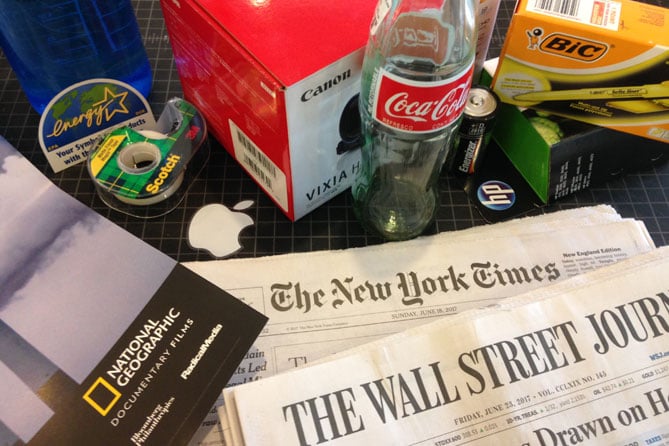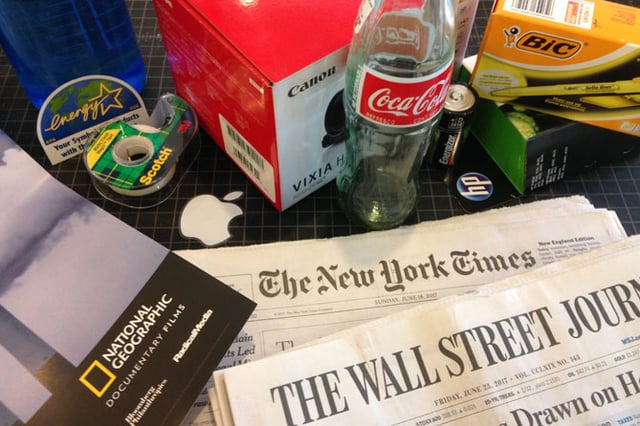How to Use Your Core Values to Inspire, Retain, and Energize Your Team
For the last few decades, but especially so in recent years, people are seeking out more than just an income from their place of employment. More...
6 min read
 Brad Pettengill
:
6/29/17 10:00 AM
Brad Pettengill
:
6/29/17 10:00 AM


You’re starting a new nonprofit, mission-driven business or your government agency program is rebranding. You want to get the best logo for your time and money but you’re not sure where to start or how to proceed. Here are some tips.
Work with your designer and creative team to establish goals, and a strategy. You’ll want to start with a creative brief so everyone's on the same page. A creative brief outlines what you want to achieve and how you plan to achieve it. Who do you want to reach? Your creative brief identifies your audience, sets up measurable goals, defines your path to achieve those goals and the tools you will use. You and your team will use this guide as you collaborate on creating your new identity.
Seeing what's out there in the marketplace and determining your place within it is a great place to start. Knowing your brand story, company culture, who you want to appeal to and what those people respond to is essential. Talk with your designer about your customers. How do you define their culture, what are their traditions, habits, ways of life? Your logo has to appeal to them, and you know them well. Also, what is your competition doing? Are you aware of the typical conventions of branding in that market? Should you follow suit or be like the companies that stand out because they don't follow trends and think "outside the box"? Strategize with your designer about how to make your logo and identity different from your competitiors and distinguish your brand in the minds of your audience.
A logo defines and represents your customer’s perception of your brand. Armed with a thorough knowledge of your brand, you and your design team will work together to make sure your identity effectively communicates your brand story. Your logo design and identity materials need to match the story of your company, your culture, and your product, service or idea. What you show the world—how you present yourself via your logo plus all other interactions your customer has with your brand—must cultivate credibility, build relationships, nurture loyalty and inspire action in your audience in order to fulfill your mission. The designer’s job is to translate your brand story into a visual, a symbol that communicates what you want to say. Your guidance is essential in facilitating that translation.
Designing a logo is about creating an image that communicates nonverbally. You and your designer will be using language that transcends the written word. You want your customer to have a positive emotional reaction and be inspired. Sometimes this is achieved by appealing to someone's existing visual vocabulary or, by giving them a surprising new association. When choosing colors, typeface(s), and image content, and deciding on shape, form, line, movement, pattern and texture, fluency in this type of communication is essential. As is sensitivity to cliché, overuse, market trends and what is tried and true for your audience. Your designer is familiar with this language and can help you make sense of all the available options.
Ask to be involved in a brainstorming session. Coming up with ideas on how to communicate your unique brand story involves in-depth exploration of the psychology of color, the form and impact of millions of typeface variations (current, classic serif, san-serif, bold, light, script, upper & lower case, all caps, letter-spacing, kerning, etc.), eyepath of layout variations, composition, overall shape and proportion, the subconscious associations of shapes, cultural norms and stereotypes, tone and style and what emotions they evoke. Don't be afraid to ask your design team for examples of how they have solved similar problems for othe clients—not just the visuals, but the stories behind the designs. The thinking that produced the final. Even the preliminary sketches if they're available, which can give you a behind-the-scenes look at their creative process.
Working with your designer will be a combination of collaboration, education, open-mindedness, discovery and trust. For both you and your designer. Don’t be afraid to step out of your comfort zone. Sometimes comfortable can result in something that looks like an off-the-shelf solution...boring. Remember, your company is as exciting and unique as the customers for whom you’re designing! Very few design decisions are made randomly, so don’t be afraid to ask your designer for the reasons or thinking behind any aspect of their work. If they've done their due diligence, you'll get an informed answer.
A good starting point is to bring examples to your designer of what you like and what you don't like, relative to your audience and your goals. Often your designer will present an overview of the competition’s logos, and other examples of design in your industry. Sometimes it can be hard to be objective and discard one's preferences and prejudices. Remember that you are designing for your customer. If you hate blue, but all research points to blue, and your designer suggests blue, try to have an open mind. And conversely—if you're seeing a lot of blue, and you know from experience that your customers respond to another palette, don't hesitate to tell your designer. Everyone needs to be open-minded when the right design for your customer appears.
And if, during this process, should you seek outside opinions or advice from the "kitchen cabinet" (friends, family and others in your circle) there are a few guidelines that are helpful to all involved: 1. Anyone weighing in needs to read the creative brief; 2. Opinions, advice, and critiques need to be accompanied by the thinking—the reasons why. The best ideas can come from anyone...

In previous blog posts I have detailed many different kinds of logo design approaches. It's an important question to ask your designer, as certain styles may be more suited to your brand than others—stylistically, historically, and for practical reasons such as cost, timing, and as explained below, usage. Go ahead, have some fun, explore some different types of logos:
Logo Design 101: The Symbol
Logo Design 101: The Wordmark
Logo Design 101: Combination Logos Pt. 1: Initials
Logo Design 101: Combination Logos Pt. 2: Seals
Logo Design 101: Combination Logos Pt. 3: The Coat of Arms, Crest & Shield
Logo Design 101: Combination Logos Pt. 4: Enclosures
Logo Design 101: Combination Logos Pt. 5: Certification, Accreditation, and Network Logos
6. How will the logo be used?
It is essential when designing to consider all the applications of your identity. Usually these are outlined in your creative brief. Knowing these immediate and potential uses will help the designer make choices for maximum legibility, consistent appearance and impact, and ability to be reproduced accurately across all media. One of the products of a comprehensive identity package should be a brand management guide which will help you and your team direct the use and application of your logo and identity materials in all situations.
Here are a few examples of identity applications:
How do you make your logo work well everywhere? In most cases, you need more than one version of your final logo:
• Create alternate versions of your mark that work in a horizontal and vertical proportion
• Make sure you have a full-color, single-color, grayscale and black and white version
• If you have a tagline, create a version without the tagline. If you have different taglines for different market segments, create them now, in the correct style, rather than adding them later
• Create simplified versions for smaller applications (like a one-half inch wide mark on a credit card, for example)
• Create simplified or truncated versions for different uses, e.g., drop the name and just use the symbol on a product.
• Create an avatar that represents key recognizable elements of your mark
• You may have variations of the mark for different markets/regions/countries/cultures
You can control how your logo appears and is used by specifying do's and dont's in your brand management guide—what colors work with the brand; when to use a reverse (white on color) version; when to use an alternate content version; how much space is required around the logo; whether you can tilt or animate or change colors of the logo, etc.
You will also need your various logo iterations in several file formats, to meet the needs of various media. Raster, or pixel-based files (JPEG, TIFF, BMP, PICT, PNG, PSD) are used for web, online, display and broadcast needs. Usually these are provided by the designer to the client in a variety of resolutions/sizes, in RGB and HEX color formats (for backlit or transmissive display needs). Vector, or line-art files (AI, EPS, SVG) are used for print, signage and other applications where scalability is needed. These are typically provided in CMYK color format (for reflective art or printed media). Your design team should provide your logo in all formats for any applications that may come up in your marketing efforts.
Your logo is an investment—in your company, in your brand, in your team and in your customer. As with any investment, how much you spend and where you spend it are critical to getting a good return for your money. A responsible and experienced designer and/or marketing team may structure an estimate with line items for any or all of the project phases: strategy, research, preliminary sketches, meeting time, revisions, final artwork creation, file preparation, style guide. The prices for each phase are typically based on estimated hours @ an hourly rate. This kind of estimate allows you to see how their fee is being allocated—for what service, and how much, you are investing. Or you may receive a flat fee, with a description of what is included. There are no hard and fast rules, with the exception that most of the time you get what you pay for.
Your logo is the symbol of the relationship between your company and your customer. A carefully considered choice of an experienced design team, thoughtful, informed and considerate collaboration on creating a new identity, and responsible brand management will virtually assure your customer has a seamless experience of your brand.
The Change Conversations blog is where changemakers find inspiration and insights on the power of mission-driven communication to create the change you want to see.
© 2009- to present, Marketing Partners, Inc. Content on the Change Conversations blog is licensed under a Creative Commons Attribution-Noncommercial-NoDerivs 3.0 United States License to share as much as you like. Please attribute to Change Conversations and link to ChangeConversations.
Creative Commons License may not apply to images used within posts and pages on this website. See hover-over or links for attribution associated with each image and licensing information.

For the last few decades, but especially so in recent years, people are seeking out more than just an income from their place of employment. More...

You know nonprofit organizations need websites just as small businesses do, but you may be surprised to learn nonprofit sites can be more complex and...

In today’s rapidly evolving media landscape, understanding where and how your story is told isn’t just strategic—it’s essential. How you communicate...